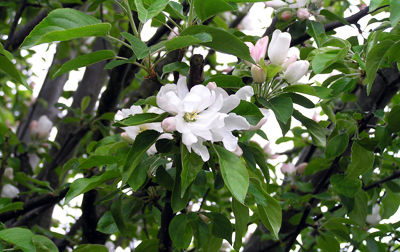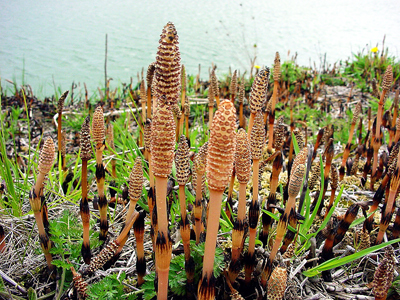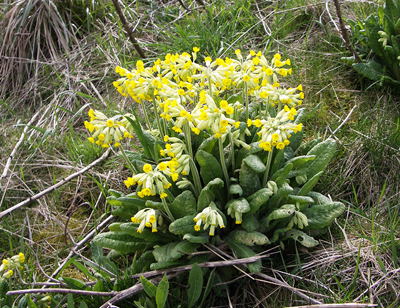The little green book that accompanied my childhood was “Wild Life Through the Year” by Richard Morse. It was published in 1942 and I particularly like the sketchbook page for every month.
So every month I am showing these pages on my blog and making my own observations, based largely on my 2010 city garden. I don’t get out much! Read earlier months here.
Traditionally April is a time of showers, but this year it has been a very dry month and I have had to water my plant containers on several occasions.
The name April is generally believed to come from the Latin word aperire, “to open”. It’s a time when the trees open into leaf and I once saw it described as “opening the gates of spring”.
While March was a golden month, April added white, blue and pink – plus a lot of green, of course. Everyone this year has been commenting on the sudden proliferation of wild violets everywhere and our garden is no exception. They grow with wild strawberries on our rockery and gravel garden.

Wild strawberry (Fragaria vesca), bluebell (Hyacinthoides non-scripta) and Herb Robert (Geranium robertianum) in April...
It seems to have been a time of waiting for the birds. They are all now singing, but they are keeping themselves to themselves, preparing nests and in some cases possibly laying eggs in secret places.
I feel pretty sure I have seen a female blue tit, great tit and dunnock round-bellied with eggs and the tits have been feeding each other, as if in preparation for the chicks – or maybe the female doesn’t want to come too near the bird table, or maybe it was just family bonding…
At the very end of the month the female blackbird is rushing around with her beak full of dried grasses and bits and pieces to make her neat nest.
Here is what you would expect to see in April in the 1940s…
1. Flowers of wild cherry 2. Blackcap singing 3. Flowers of crab apple 4. Early purple orchis 5. Small white butterfly 6. Seven-spot ladybird 7. Fertile stem of field horsetail 8. Cowslip 9. Eggs of newt in leaves of water-weed 10. Wall screw-moss 11. Ring-Ousel 12. Grey squirrel
1. Flowers of wild cherry
Well, I wouldn’t expect to see wild cherries in the city, but April is blossom time here and we have plenty of ornamental cherries. I have been out with my camera a couple of times – you can see more of my images on Flickr.
The Latin name for the wild cherry or gean is Prunus avium.
2. Blackcap singing
Throughout April the pair of blackcaps (Sylvia atricapilla) in the garden have been pretty quiet and secretive, but I have glimpsed the female again in the last week, so they are still around. It would be good if they have babies here.
3. Flowers of crab apple
I have an aversion to crab apple trees, as we had one in the front garden when we moved in here, decades ago, and it was diseased from day one, with a horrible leaf rust that meant they all dropped off before their time. And the fruits made a mess on the lawn.
But one of our neighbours still has one, a slightly more decorative variety, and its pink buds opened in the sun during the last few days of the month. This is an ornamental variety of Malus, but the wild form is Malus sylvestris.
Crab apples are bitter but make a tasty jelly.
4. Early purple orchis
Although, according to this British orchid guide, the early purple orchid (Orchis mascula) is still widespread and common in Britain, I don’t think this part of South Wales is in its territory. So I will just have to admire the pretty picture and move on…
5. Small white butterfly
The small white butterfly (Pieris rapae) is commonly known as one of the “cabbage whites” as its green caterpillars wreak havoc in the vegetable garden.
They usually start emerging in April but I haven’t seen any yet. in fact so far I have seen only one butterfly in the garden – a speckled wood (Pararge aegeria).

The invasive harlequin ladybird comes in a wide range of patterns and threatens native seven-spot and one-spot ladybirds in Britain...
6. Seven-spot ladybird
When “Wild Life Through the Year” was written, Britain had two main ladybirds (family Coccinellidae), the two-spot and the seven-spot.
For an American audience I had better explain a ladybird is a ladybug. Either way, they are considered lucky and are named after the Virgin Mary, who wore a red cloak in early religious paintings. In Welsh they are called buwch goch gota, meaning “cow red coat”.
Ladybirds were common in my childhood and I remember counting the spots. Many was the time I forced a ladybird to climb on to the back of my hand and blew on it to make it uncover its wings:
Ladybird, ladybird, fly away home
Your house is on fire
And your children have gone…
This rhyme dates back to at least 1744, according to Wikipedia, which also has other versions of the rhyme and some possible explanations.
Today our British native ladybirds are under threat from the alien harlequin ladybird, Harmonia axyridis, the most invasive ladybird on earth. The first of these reached Wales in 2006 (see here).
7. Fertile stem of field horsetail
The horsetail (Equisetum) is often called a living fossil. A distant relative of ferns, it has survived from Palaeozoic times, when it formed the understory of the forest from around 500 to 250 million years ago. At the time it had relatives growing to tree size.
Today the horsetail is also known as an annoyance in one of my neighbour’s gardens. Even if you remove the shoots, the deep roots of established colonies will re-grow and it takes a lot of effort and perhaps glyphosate to get rid of it.
One thing you don’t do is grab horsetail stems with bare hands – they are very high in sharp silica content and will cut your skin. On the bright side, this high silica content has made horsetail a remedy for skin, hair and nails and even for osteoporosis.
8. Cowslip
The cowslip (Primula veris) was SO common in my childhood in the 1960s. It naturally grows in pastures and meadows but I guess farming has probably affected its habitats. Certainly I have not seen cowslips for years and it is now more likely to grow on motorway verges than its old haunts.
The flowers are like very small primrose flowers in a bunch and indeed it is a close relative of the primrose.

Palmate newt (Lissotriton helveticus) - I usually find one in the garden in summer - this is a lovely illustration by Joanne Glover - click on the picture to see her portfolio...
9. Eggs of newt in leaves of water-weed
I have never noticed these – but then in the modern city I don’t go very near country ponds. However, we do sometimes find newts in the garden as there are underground springs nearby. The species we have here is the palmate newt (Lissotriton helveticus). It is easily recognised by its webbed back feet.
10. Wall screw-moss
A-ha! I can do this one. We have lots of wall screw-moss (Tortula muralis) in the garden and I have been watching it since January. Although it would probably be looking better right now if April had been as showery as you would expect. The dry weather hasn’t done much for the moss’s looks.
11. Ring-Ousel
This is now usually called the ring ouzel, rather than ousel. It’s similar to a blackbird but really quite rare. Certainly you wouldn’t see it in these parts. It spends summer in the North and West of Britain and can sometimes be seen passing through from the continent in the far South East in April. Read more on the RSPB site.
12. Grey squirrel
Well, what can I say? The grey squirrels are like family! We have three living in the garden at any one time, currently a big old male, a female and a young skinny male.
Although they eat far too many peanuts and make a mess of our containers with their digging around, these “tree rats” have a certain charm.
They look funniest when they stand on their hind legs, with their forepaws crossed, looking around like meerkats or when they sit on a branch in the morning sun and preen themselves, or leap at the bird table and don’t quite make it and show their surprise and embarrassment.
The Latin name is Sciurus carolinensis and the grey squirrel was brought to Britain in the late 19th and early 20th century. It has now pretty well driven out the red squirrel in Southern Britain, although it is less common in Scotland.
If you are interested, here are some more pictures from my garden in April…
See other months in the Wildlife Through the Year archive













Leave a comment